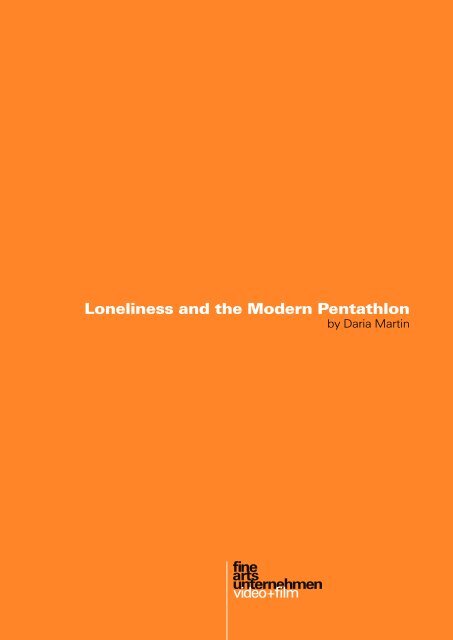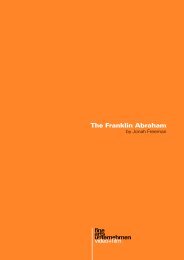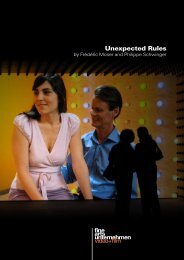Loneliness and the Modern Pentathlon - Fine Arts Unternehmen
Loneliness and the Modern Pentathlon - Fine Arts Unternehmen
Loneliness and the Modern Pentathlon - Fine Arts Unternehmen
Create successful ePaper yourself
Turn your PDF publications into a flip-book with our unique Google optimized e-Paper software.
<strong>Loneliness</strong> <strong>and</strong> <strong>the</strong> <strong>Modern</strong> <strong>Pentathlon</strong><br />
by Daria Martin
<strong>Loneliness</strong> <strong>and</strong> <strong>the</strong> <strong>Modern</strong> <strong>Pentathlon</strong><br />
by Daria Martin<br />
The project<br />
This 20 minute, 16mm film creates a utopian fiction<br />
around <strong>the</strong> <strong>Modern</strong> <strong>Pentathlon</strong> discipline (running,<br />
swimming, shooting, fencing, <strong>and</strong> horseback riding),<br />
springboarding from this arcane Olympic sport to an<br />
investigation of <strong>Modern</strong>ity, Romanticism, <strong>and</strong> <strong>the</strong> struggle<br />
for wholeness. Folding sport, dance, painting, sculpture,<br />
architecture, <strong>and</strong> music into <strong>the</strong> medium of film, it lightly<br />
strives to become a contemporary “Gesamtkunstwerk”<br />
(total artwork) - an updated Bauhaus experiment informed<br />
by 60’s New Wave filmmaking.<br />
Film data<br />
Year:<br />
2005<br />
Original format:<br />
16mm<br />
Duration:<br />
20 minutes<br />
2<br />
www.fineartsunternehmen.com
<strong>Loneliness</strong> <strong>and</strong> <strong>the</strong> <strong>Modern</strong> <strong>Pentathlon</strong><br />
by Daria Martin<br />
Artist’s statement<br />
Building on my previous films’ concerns, “<strong>Loneliness</strong><br />
<strong>and</strong> <strong>the</strong> <strong>Modern</strong> <strong>Pentathlon</strong>” will heighten <strong>and</strong> <strong>the</strong>n<br />
diffuse tensions between <strong>the</strong> intimately linked poles of<br />
aspiration <strong>and</strong> its limits in exhaustion, between forwardlooking<br />
modernity <strong>and</strong> backward-looking romanticism.<br />
The film takes as its starting point <strong>the</strong> discipline of <strong>the</strong><br />
<strong>Modern</strong> <strong>Pentathlon</strong>, an arcane but still surviving Olympic<br />
sport comprised of running, swimming, shooting,<br />
horseback riding, <strong>and</strong> fencing. Its five formalized<br />
events were chosen by Baron de Coubertin, founder<br />
of <strong>the</strong> <strong>Modern</strong> Olympics, to encapsulate <strong>the</strong> romantic<br />
adventures of a gentleman liaison officer who fights his<br />
way on horseback, foot, <strong>and</strong> finally through water, to<br />
deliver an urgent message.<br />
“<strong>Loneliness</strong> <strong>and</strong> <strong>the</strong> <strong>Modern</strong> <strong>Pentathlon</strong>” archly hangs this<br />
rarified sporting discipline on <strong>the</strong> general structure of <strong>the</strong><br />
British Angry Young Man film classic “The <strong>Loneliness</strong> of<br />
<strong>the</strong> Long Distance Runner” (1962). This newly imagined<br />
version will also be set in an isolated school in rural<br />
Engl<strong>and</strong> <strong>and</strong> will likewise plumb <strong>the</strong>mes of individualism<br />
versus collectivity. Yet, crucially, elements have changed<br />
. . . In “<strong>Loneliness</strong> <strong>and</strong> <strong>the</strong> <strong>Modern</strong> <strong>Pentathlon</strong>,” a<br />
charismatic headmistress (ra<strong>the</strong>r than headmaster),<br />
played by an iconic film star, presides over <strong>the</strong> daily life<br />
of her charges, a group of young <strong>Modern</strong> Pentathletes.<br />
The surveying gaze of this authoritarian but sensual<br />
coach puts into perspective <strong>the</strong> athletes’ communal<br />
activities. Her regard –sometimes tender, sometimes<br />
cool-- is echoed by <strong>the</strong> observations of a roving camera in<br />
a flowing series of vignettes which accumulate in a loose<br />
<strong>and</strong> poetic rhythm ra<strong>the</strong>r than a strict narrative.<br />
The film subtly plays up <strong>the</strong> performative, formal<br />
qualities of <strong>the</strong> existing <strong>Modern</strong> <strong>Pentathlon</strong> discipline,<br />
bending <strong>the</strong>m from truth to fiction. The green place<br />
where <strong>the</strong> youths of this film reside resembles a strange<br />
combination of military academy, hippy commune,<br />
<strong>and</strong> early modern utopian community. Despite <strong>the</strong> fact<br />
3<br />
www.fineartsunternehmen.com
<strong>Loneliness</strong> <strong>and</strong> <strong>the</strong> <strong>Modern</strong> <strong>Pentathlon</strong><br />
by Daria Martin<br />
// Artist’s statement<br />
that <strong>the</strong> athletes seem to be imprisoned in rigorous<br />
routine, <strong>the</strong>y also appear to enjoy a surprisingly loose<br />
camaraderie, a hopeful spirit. Practicing <strong>the</strong>ir five sports<br />
toge<strong>the</strong>r in a rippling choreography <strong>and</strong> –unexpectedly-<br />
- sitting peacefully side by side at <strong>the</strong>ir daily activity of<br />
weaving at <strong>the</strong> loom, <strong>the</strong>y appear to make up an odd<br />
kind of ideal civilization, simultaneously unfettered yet<br />
disciplined, <strong>the</strong>ir emotions intense but contained.<br />
“<strong>Loneliness</strong> <strong>and</strong> <strong>the</strong> <strong>Modern</strong> <strong>Pentathlon</strong>” humorously<br />
attempts an optimistic, slightly awkward, artistic<br />
syncretism, weaving toge<strong>the</strong>r <strong>and</strong> fusing genres <strong>and</strong><br />
disciplines in a playful way. Portrayed by dancers as<br />
well as Olympic hopefuls, <strong>the</strong> athletes in <strong>the</strong> film meld<br />
sport with dance, so that <strong>the</strong>ir activities create a new<br />
genre of experimental physical movement. The film is<br />
saturated with painterly color <strong>and</strong> shot through with visual<br />
references to hopeful avant-garde moments as diverse as<br />
Bauhaus director Oskar Schlemmer’s fantastical <strong>the</strong>ater<br />
<strong>and</strong> Joan Jonas’ tactile performance art. Gracing <strong>the</strong><br />
athletes’ costumes are woven b<strong>and</strong>s of color; <strong>the</strong>se<br />
five colors, close to <strong>the</strong> Olympic signature, appear also<br />
in eccentric additions to sporting gear . . . <strong>the</strong> athletes<br />
paint white lines on a lawn to mark out a fencing field;<br />
<strong>the</strong> lines become drawing . . . a row of ascending <strong>and</strong><br />
descending arms at <strong>the</strong> shooting range becomes dance.<br />
In a sense, <strong>the</strong> film lightly strives towards a kind of ‘artistic<br />
pentathlon,’ a humorous 21st century embodiment of<br />
what Sonia Delaunay called, in <strong>the</strong> 1920’s, “Simultaneous<br />
Art” or what <strong>the</strong> Bauhaus idealized as “Gesamtkunstwerk:<br />
” Total Artwork.<br />
This struggle of <strong>the</strong> early avant-garde for wholeness<br />
–its passionate urgency <strong>and</strong> its ultimate disappointment-<br />
- is reflected in <strong>the</strong> history of <strong>the</strong> <strong>Modern</strong> <strong>Pentathlon</strong><br />
discipline itself. Invented in 1909 by Baron de Coubertin,<br />
a French aristocrat whose fa<strong>the</strong>r was an artist, <strong>the</strong><br />
<strong>Modern</strong> <strong>Pentathlon</strong> was meant to test <strong>the</strong> metal of <strong>the</strong><br />
ultimate “complete athlete”--its five events echoing <strong>the</strong><br />
five Olympic rings, creating a circle of total realization<br />
that enclosed mental as well as physical prowess. The<br />
<strong>Modern</strong> <strong>Pentathlon</strong> today strips itself of sentimental<br />
associations <strong>and</strong> strives to remain ‘<strong>the</strong> ultimate Olympic<br />
event,’ yet relentlessly fails to escape its marginal status.<br />
Its position as a ‘minority’ sport seemed insured already<br />
at its inception, as even in 1909 it was anachronistic to<br />
model a contemporary sport on an aristocratic archetype.<br />
From <strong>the</strong> beginning, <strong>the</strong> <strong>Modern</strong> <strong>Pentathlon</strong> was<br />
paradoxically tinged with both a flush of ambition <strong>and</strong> a<br />
grayish cast of loss.<br />
“<strong>Loneliness</strong> <strong>and</strong> <strong>the</strong> <strong>Modern</strong> <strong>Pentathlon</strong>” will embody<br />
this special irony, toying with <strong>the</strong> delightful absurdity<br />
<strong>and</strong>, indeed, <strong>the</strong> loneliness inherent in a single person’s<br />
aspiration to master five disciplines, to exp<strong>and</strong> into a<br />
“modern” super-person. Each athlete, changing costume,<br />
equipment, <strong>and</strong> action for every sport, creates distinct<br />
identities throughout <strong>the</strong> film; personas subtly change with<br />
attire <strong>and</strong> attitude, <strong>and</strong> this process is highlighted by brief<br />
“locker room” scenes depicting physical transformations<br />
<strong>and</strong> barely discernible psychological shifts. Particular<br />
athletes are highlighted across transitions –shedding<br />
old skins <strong>and</strong> adopting new ones-- to make bodily <strong>and</strong><br />
psychic transformations more <strong>the</strong>atrically visible.<br />
The notion of chameleon-like role-playing, or splitting<br />
of identity, will be fur<strong>the</strong>r deepened by <strong>the</strong> casting of<br />
<strong>the</strong> headmistress’s role. Played by a recognizable star<br />
of avant-garde film, her presence will evoke a life of<br />
multiple identities <strong>and</strong> journeys through many roles<br />
–an ego simultaneously imperious <strong>and</strong> highly flexible. In<br />
focusing on this singular, recognizably unique individual<br />
who remains distinct from a miniature army of masterful<br />
individuals, <strong>the</strong> film hints at questions of collective versus<br />
individual identities, <strong>and</strong> how <strong>the</strong>se are each formed<br />
through layered role-playing. Moreover, this actress,<br />
an Olympian of <strong>the</strong> screen, a goddess of a golden age,<br />
bears a curious, preexisting, relationship to time <strong>and</strong> to<br />
collective culture: <strong>the</strong> mark of experience etched in her<br />
face, she never<strong>the</strong>less remains timeless in <strong>the</strong> cumulative<br />
4<br />
www.fineartsunternehmen.com
<strong>Loneliness</strong> <strong>and</strong> <strong>the</strong> <strong>Modern</strong> <strong>Pentathlon</strong><br />
by Daria Martin<br />
// Artist’s statement<br />
memories of countless individuals. Like <strong>the</strong> <strong>Modern</strong><br />
<strong>Pentathlon</strong> discipline itself, she folds time.<br />
In “<strong>Loneliness</strong> <strong>and</strong> <strong>the</strong> <strong>Modern</strong> <strong>Pentathlon</strong>,” this actress’s<br />
iconic yet vulnerable quality in a sense subtly st<strong>and</strong>s<br />
in as a metaphor for our contemporary relationship to<br />
<strong>Modern</strong>ism itself--<strong>Modern</strong>ism is resilient aristocrat, a star<br />
who refuses to grow old gracefully. The young athletes<br />
of <strong>the</strong> film provide a counterpoint, representing <strong>the</strong><br />
blindly striving naiveté, only slightly darkened by teen<br />
angst <strong>and</strong> worry. These two faces, one innocent <strong>and</strong><br />
one experienced, are each sides of a coin, a paradox that<br />
begins to encapsulate our contemporary ambivalence<br />
towards what it might mean to be ‘modern’ people<br />
today.<br />
In gently investigating <strong>the</strong> struggle inherent in <strong>the</strong> dream<br />
of becoming a ‘rounded’ individual-- a person of heroic<br />
self-mastery as well as of submission to community-<br />
- “<strong>Loneliness</strong> <strong>and</strong> <strong>the</strong> <strong>Modern</strong> <strong>Pentathlon</strong>” hints that<br />
assuming this role requires a great deal of dress up,<br />
poker-faced disguise, <strong>and</strong> slapstick experimentation.<br />
In oscillating between passionate urgency <strong>and</strong> formal<br />
restraint, it finds an escape from <strong>the</strong>se opposed poles<br />
in what Schlemmer described as <strong>the</strong> “play instinct:” a<br />
joyous celebration of transformation, a delight in artifice.<br />
5<br />
www.fineartsunternehmen.com
<strong>Loneliness</strong> <strong>and</strong> <strong>the</strong> <strong>Modern</strong> <strong>Pentathlon</strong><br />
by Daria Martin<br />
Artist’s info<br />
Born in San Francisco, 1973. Lives <strong>and</strong> works in<br />
London.<br />
EDUCATION <strong>and</strong> AWARDS<br />
2002 Artist in residence, Delfina Studios Trust, London.<br />
2000 M.F.A., cum laude, University of California, Los<br />
Angeles.<br />
1999 Artist in Residence, Cite Internationale des <strong>Arts</strong>,<br />
Paris, France.<br />
1995 B.A., Humanities, magna cum laude, Phi Beta Kappa,<br />
Yale University .<br />
ONE PERSON EXHIBITIONS<br />
2005 Five Fights, Kunstverein in Hamburg, Hamburg. /<br />
Daria Martin, Kunsthalle Zurich, Zurich. / Man <strong>and</strong> Mask,<br />
Collective Gallery, Edinburgh. / Daria Martin, Kunstlerhaus<br />
Stuttgart, Stuttgart. / Soft Materials, The Showroom,<br />
London.<br />
2004 Daria Martin: Closeup Gallery, Hotel, London.<br />
2003 Daria Martin: Art Now Lightbox, Tate Britain, London.<br />
/ Closeup Gallery, Analix Forever Gallery, Geneva.<br />
2001 Birds, Andrea Rosen Gallery, New York.<br />
SELECTED GROUP EXHIBITIONS<br />
2005 The Tate Triennial, Tate Britain, London (catalogue). /<br />
The British Art Show 6, The Baltic Centre for Contemporary<br />
Art, Gateshead. / Uncertain States of America, Astrup<br />
Fearnley Museum of <strong>Modern</strong> Art, Oslo. / A Certain<br />
Tendency in Representation, Thomas Dane Gallery,<br />
London. / Emblematic Display, curated by Ca<strong>the</strong>rine Wood,<br />
Institute of Contemporary <strong>Arts</strong>, London. / U-Move, Galleria<br />
Comunale d’Arte Contemporanea di Monfalcone, Italy<br />
(catalogue). / Beck’s Futures, Institute of Comtemporary<br />
<strong>Arts</strong>, London, <strong>and</strong> o<strong>the</strong>rs (catalogue).<br />
2004 In <strong>the</strong> Palace at 4 a.m., curated by Ca<strong>the</strong>rine Wood,<br />
Alison Jacques Gallery, London. / 100 Artists See God,<br />
curated by John Baldessari <strong>and</strong> Meg Cranston, Institute<br />
of Contemporary <strong>Arts</strong>, London, <strong>and</strong> o<strong>the</strong>rs (catalogue). /<br />
Feast of Silenus, Edinburgh College of Art, Edinburgh. /<br />
Sophie Macpherson <strong>and</strong> Daria Martin, Glasgow Sculpture<br />
Studios, Glasgow.<br />
2003 The <strong>Modern</strong>s, Museo Castello di Rivoli, Turin<br />
(catalogue). / Paris is Burning, Entwistle Gallery, London.<br />
/ Bootleg, Spitalfields Market, London. / The Fragile<br />
Underground, curated by David Thorpe, Bart Wells<br />
Institute, London.<br />
2002 Al Respecto 7, Rafael Tous Foundation, Barcelona.<br />
2001 Tirana Biennale, National Gallery, Tirana (catalogue).<br />
/ Sharing Sunsets, Tuscon Museum of Contemporary Art,<br />
Tuscon. / Not at Home, Solitude Gallery, Stuttgart.<br />
2000 Sentimental Education, curated by David Rimanelli,<br />
Deitch Projects, New York. / And She Will Have Your Eyes,<br />
Analix Forever Gallery, Geneva. / New School, Works on<br />
Paper, Los Angeles. / M.F.A. Thesis Show, UCLA New<br />
Wight Art Gallery, Los Angeles.<br />
1999 Black Dragon Society, Black Dragon Society, Los<br />
Angeles.<br />
SELECTED PERFORMANCES, SCREENINGS, <strong>and</strong><br />
BROADCAST<br />
2006 Regeneration, Tate <strong>Modern</strong> Turbine Hall, performance<br />
in collaboration with Zeena Parkins. / Diaries, Poor Man’s<br />
Expression, Berlin, Germany (performance). / Dance<br />
<strong>and</strong> Art in London, Suzanne Dellel Center, Tel Aviv, Israel<br />
(screenings <strong>and</strong> lectures). / British Art Talks: Music,<br />
Tate Britain, London (lecture <strong>and</strong> panel discussion). /<br />
Joseph Cornell: Arnolfini Bristol (screening <strong>and</strong> lecture).<br />
/ Daria Martin, Bonniers Kunsthalle, Stockholm, Sweden<br />
(screening <strong>and</strong> lecture).<br />
2005 Daria Martin (screening <strong>and</strong> talk), Swiss Centre,<br />
Paris. / Daria Martin: Screenings, Casco Projects, Utrecht.<br />
/ Flesh <strong>and</strong> Fantasy ,film night curated by Daria Martin,<br />
Tate Britain, London. / The New <strong>Modern</strong>s, Second Annual<br />
Conference, The Showroom, London. / Ed Ruscha Film<br />
Night, Museum of Contemporary Art, Los Angeles. /<br />
Describing Form, screenings curated by Lucy Reynolds<br />
6<br />
www.fineartsunternehmen.com
<strong>Loneliness</strong> <strong>and</strong> <strong>the</strong> <strong>Modern</strong> <strong>Pentathlon</strong><br />
by Daria Martin<br />
// Artist’s info<br />
for LUX, The Henry Moore Institute, Tate Britain, <strong>and</strong><br />
o<strong>the</strong>rs.<br />
2004 The New Female Voyeurism (screening <strong>and</strong> panel<br />
discussion), The Institute of Contemporary <strong>Arts</strong>, London.<br />
/ bfi <strong>and</strong> Tate: International Symposium: By Design:<br />
Film Fashion / Art Architecture (screening <strong>and</strong> talk), Tate<br />
<strong>Modern</strong>, London. / Spring is <strong>the</strong> Future (performance),<br />
Concert in <strong>the</strong> Egg, curated by Emma Robertson <strong>and</strong> Jo<br />
Stella-Sawicka, The Ship, London.<br />
2002-2005 Revolver, a series of short films by artists,<br />
curated by Carmen Zita, broadcast weekly on <strong>the</strong> European<br />
arts Channel “Expo 24X7”.<br />
SELECTED BIBLIOGRAPHY<br />
2006 Kirsty Bell, ‘Track <strong>and</strong> Field” (feature), frieze, March<br />
2006. / Barry Schwabsky, “Openings: Daria Martin”,<br />
Artforum, March 2006. / Olivia Plender, “Greek Myth <strong>and</strong><br />
<strong>the</strong> Ghosts of Bexhill-on-Sea,” Tate Etc, Spring 2006.<br />
2005 “Brit Art: <strong>the</strong> Next Generation”, The Independent, 1<br />
December, 2005.* / “Future Greats,” Art Review, December<br />
2005.* / David Bussel, “Daria Martin: The Showroom”<br />
(review), Artforum, May 2005.* / Lisa Panting, “Daria<br />
Martin: The Showroom” (review), frieze, April 2005.* /<br />
Diana Baldon, “Daria Martin interviewed”, tema celeste,<br />
March/ April 2005.* / Sally O’Reilly, “Daria Martin: The<br />
Showroom” (review), <strong>Modern</strong> Painters, April 2005.* / Lisa<br />
Le Feuvre, “Daria Martin: The Showroom” (review), Art<br />
Monthly, March 2005.* / Rob Tufnell, “Eye Robot”, Tank,<br />
January 2005.* / Pablo Lafuente, “Debut: Daria Martin”,<br />
Art Review, January, 2005.*<br />
2004 David Bussel, “Critics’ Picks: Closeup Gallery”,<br />
Artforum Online, November, 2004.* / Sanjoy Roy, “Moving<br />
<strong>the</strong> Goalposts”, Contemporary, issue 66, October, 2004. /<br />
cover image.* / Emily Pethick, “London Picks: In <strong>the</strong> Palace<br />
at 4 am” Artforum Online, July, 2004. / “Palace Evolution”,<br />
Time Out, 28 July-4 August 2004.* / Olivia Plender, “On<br />
Daria Martin”, Untitled, Spring 2004.* / Barbara Polla,<br />
“Daria Martin <strong>and</strong> <strong>the</strong> <strong>Modern</strong> <strong>Pentathlon</strong>”, Citizen K,<br />
Paris, Winter 2004.*<br />
2003 Andrea Viliani,“Daria Martin”, (review), Flash Art<br />
International, Milan, October, 2003.* / Roberta Bosco,<br />
“Quienes son los modernos?”, El Pais, Madrid, May 2,<br />
2003.* / “Contemporanei? No, <strong>Modern</strong>i”, La Repubblica,<br />
Rome, April 5, 2003.*<br />
2002 Pablo Lafuente, “A room of <strong>the</strong>ir own”, Artreview,<br />
London, November 2002. / Es<strong>the</strong>r Pierini, “Birds” (review),<br />
frieze, London, April 2002.* / Maurizio Cattelan, curator,<br />
Charley 01, New York, Spring 2002.*<br />
2001 David Rimanelli, “First Take: Daria Martin”, Artforum,<br />
New York, January 2001.*<br />
2000 Holl<strong>and</strong> Cotter, “Sentimental Education” (review),<br />
The New York Times, / New York, July 14, 2000. / Jerry<br />
Saltz, “Realm of <strong>the</strong> Senses”, The Village Voice, New<br />
York, July 6, 2000. / David Rimanelli, “Top Ten of 2000”,<br />
Artforum, New York, December 2000. / *Reproductions.<br />
PUBLICATIONS<br />
2006 Daria Martin, Ringier, Zurich. / Tate Triennial, Tate<br />
Publications, London.<br />
2005 The British Art Show 6, Hayward Art Gallery, London.<br />
/ Uncertain States of America, Astrup Fearnley Museum<br />
of <strong>Modern</strong> Art, Oslo. / The Showroom Annual 2004-2005,<br />
The Showroom, London. / U-Move, Galeria Comunale<br />
d’Arte Contemporanea di Monfalcone, Italy. / Beck’s<br />
Futures, Institute of Contemporary <strong>Arts</strong>, London.<br />
2004 100 Artists See God, Independent Curators<br />
International, New York. / Art Now <strong>and</strong> Then, Tate Britain,<br />
London.<br />
2003 I <strong>Modern</strong>i/ The <strong>Modern</strong>s, Castello di Rivoli, Turin.<br />
2001 Tirana Biennale, National Gallery, Tirana. /<br />
SELECTED COLLECTIONS<br />
Tate <strong>Modern</strong>, London.<br />
<strong>Arts</strong> Council Engl<strong>and</strong>, London.<br />
Ringier, Zurich.<br />
7<br />
www.fineartsunternehmen.com
fine arts unternehmen ag<br />
obmoos 4 / ch-6301 zug (switzerl<strong>and</strong>)<br />
phone +41 41 711 68 20 / fax +41 41 711 54 15<br />
filmbox@artisart.com<br />
www.fineartsunternehmen.com








